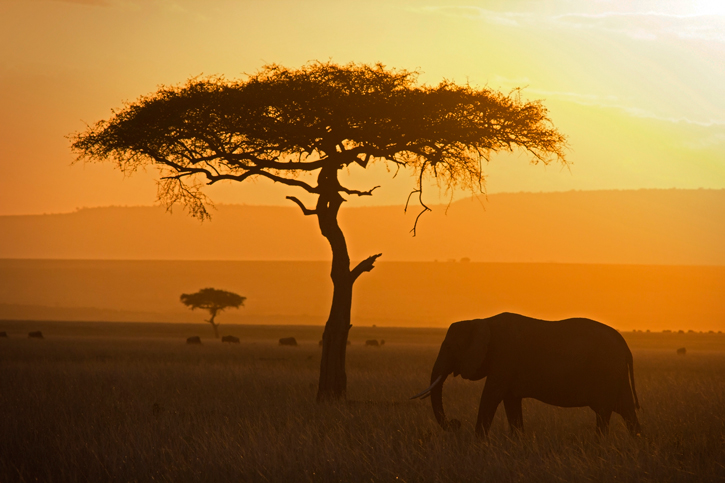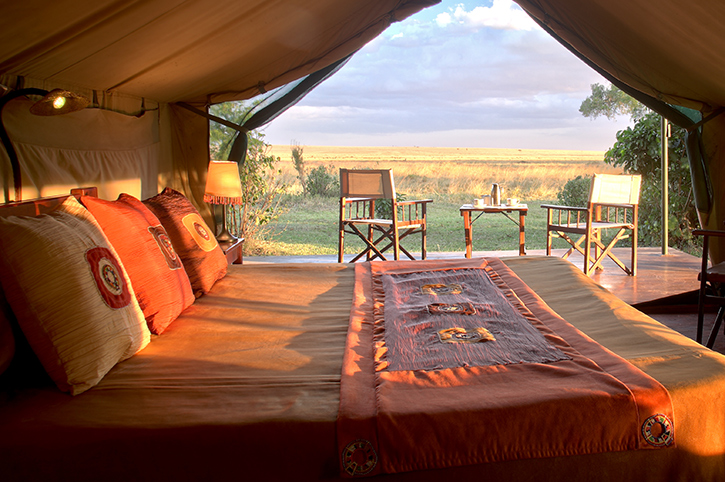
Kenya’s Masai Mara and the Serengeti in Tanzania are two of Africa’s most iconic destinations for wildlife safaris. Both parks provide an excellent opportunity to see Africa’s ‘Big 5’ of lion, leopard, elephant, rhino and buffalo, not to mention other spectacular sightings of cheetah, hippo, zebra and giraffe. There are no fences between the Masai Mara and the Serengeti so animals can travel freely between the two reserves.
So, how to choose between the two for your next safari? In this guide we’ll cover:
Although they are in two different countries, the Serengeti and Masai Mara are essentially next-door neighbours across a political line; the Masai Mara sits on Kenya’s southwest boundary, whilst the Serengeti is adjacent to Tanzania’s north west border.
The Serengeti is vast, covering more than 18,000 square miles and includes various landscapes from rocky outcrops and forests to sprawling grasslands. The Masai Mara is more compact at just under 1,000 square miles, providing beautiful rolling hills interspersed with shady Acacia trees. Both areas benefit from big rivers attracting an abundance of life.

There is never a bad time to go on safari in Africa! However, whilst both the Serengeti and the Masai Mara offer year round wildlife viewing, the change in seasons affects which animals are on the move and you’ll be most likely to see in the greatest numbers.
The dry season in the Serengeti, between June and October, offers the best wildlife viewing opportunities; Firstly because the grasses become shorter making all animals easier to spot and secondly because many animals will need to regularly visit or congregate around water sources. However there are exceptions. The southern areas of the Serengeti can see rain from December to February, keeping the grasslands green for the grazing wildebeest herds. This is also the spark that lights the wildebeest calving season, that in turn attracts large cats in search of easier prey.
Generally, wildebeest and zebra stay in the southern Serengeti until April. Then, as the dry season takes hold, they begin to move north, reaching the border with the Masai Mara around July.
In the Masai Mara, wildlife viewing is usually at its best during the drier months of June to October and December to March. The lack of rain sees resident animal activity concentrate around rivers and waterholes, making wildlife viewing experiences easier to locate. The great wildebeest migration in the Masai Mara is usually between July and October as the animals leave the drier Serengeti in search of greener pastures.
Witnessing the great migration of wildebeest herds across the plains has become a bucket-list item for many travellers, with numerous wildlife documentaries have making famous the perilous journey. As the dry season hits the Serengeti from May onwards the giant wildebeest herds instinctively begin to move north in search of greener pastures. More than 1.5 million animals are estimated to undertake the great migration, often referred to as “the greatest show on earth”.
Viewing the swathes of animals cross the Grumeti River in the Serengeti can be done through June and July. The animals are very spread out, so there is not just one crossing point, but rather many stages, as animals pluck up the courage to cross the water.

Timings of the great migration do vary, but usually from July through to October the herds have reached the Masai Mara, where the great Mara River poses another dangerous obstacle. The large wildebeest herds are joined by zebras and antelope providing a full and varied menu for the waiting carnivores, who patrol their grassland territories, through which they must pass. In addition, crocodiles lay hidden in the muddy waters at the bottom of the steep riverbank.
Late July to mid-October is the classic ‘migration season’ for the Masai Mara. By late October the herds begin to drift south again in anticipation of the short rains which will breathe life back into the grassy plains of the southern Serengeti. The great migration cycle then begins all over again.
Both the Serengeti and Masai Mara have a variety of purpose-built lodges and luxury camps, with something for all budgets. If you haven’t been on safari before, then the idea of camping in the bush may sound unappealing, but these luxury camps are nothing like a scout camp. You can expect large safari tents, big beds, soft bed linen and your own en suite bathroom. Camps are often located in sheltered or shady areas within the parks, close to rivers or other water sources where wildlife converge.
In general, safari lodges tend to be more like a traditional, small hotel or an arrangement of bungalows around a central building. Often, they are located near a park entrance or within a private conservancy on the park’s edge.
There are many lodges and camps to choose from in both the Masai Mara and the Serengeti. Here are just a few examples hand-selected by Freedom Destinations’ Africa Experts:


An African safari holiday is something that usually needs to be planned well in advance. It usually incorporates multiple travel elements, accommodation options and various activities, so some forethought is required. Your time on safari can range from a couple of days to a week or more, but however long you can stay in the Masai Mara and the Serengeti, you will want to make the most of your time. As well as the traditional 4×4 safari, you may wish to explore on foot or even a balloon safari experience. Not all properties can offer these options, so add these to your plans from the start.

The Masai Mara is a great location for game viewing. As well as the big moments like the Great Migration, it can provide intimate moments with individual animals as well as numerous activities. Kenya can provide excellent value, so often the Mara is a good destination for a first safari experience. If you can, look to add something like a morning balloon safari over the Masai Mara to give you a unique perspective on the wilderness around you.
A safari in Tanzania’s Serengeti provides access to varied environments for game viewing. You can combine time on the plains with the Ngorongoro crater, which provides a lush mountain landscape and great game viewing. However, due to the greater distances covered, prices can be a bit higher than a similar length safari holiday in Kenya.

Having organised safari holidays for hundreds of travellers, we thought we’d give Maritha, in the Africa Team at Freedom Destinations, the final word on which is best; the Masai Mara or Serengeti?
“Both are incredible destinations! For a first time safari, I usually recommend the Masai Mara. There are regular flights to and from Nairobi and a great variety of camps and lodges in the park to choose from, something for all tastes and budgets. Wildlife viewing in the Mara is always good and there is a great chance to see the ‘Big 5’, sometimes in one day!”
“I find that the varied landscapes of Tanzania and the Serengeti are popular with returning customers that have been to Africa before and want to see something a little different. Combining time on the savannah of the Serengeti with a safari in the Ngorongoro Crater is a quite exceptional experience. The distances travelled may be a little further, but it is well worth it.”
“I often suggest combining a safari with a beach holiday. On safari you are active when the animals are. This means you can be up before dawn, but then who doesn’t enjoy a sundowner at the end of the day? After a few days in the wild, it is even sweeter to enjoy a late morning breakfast followed by a swim in the sea or the pool. You can’t beat that combination!”
“I will promise you one thing…. holidays in Africa are addictive. Once you have sampled a safari you will always want to come back to see more!”
When planning your safari, it can help greatly to have an experienced hand to guide you and create the perfect holiday for you. Freedom Destinations’ Africa experts are perfectly placed to do just that.
Safari holidays by Freedom Destinations.
Richard has more than 25 years of experience working within the travel industry. He has travelled widely in Europe, the USA & Canada, Australia & New Zealand, South East Asia, as well as Southern Africa. He enjoys exploring National Parks and other wilderness areas.